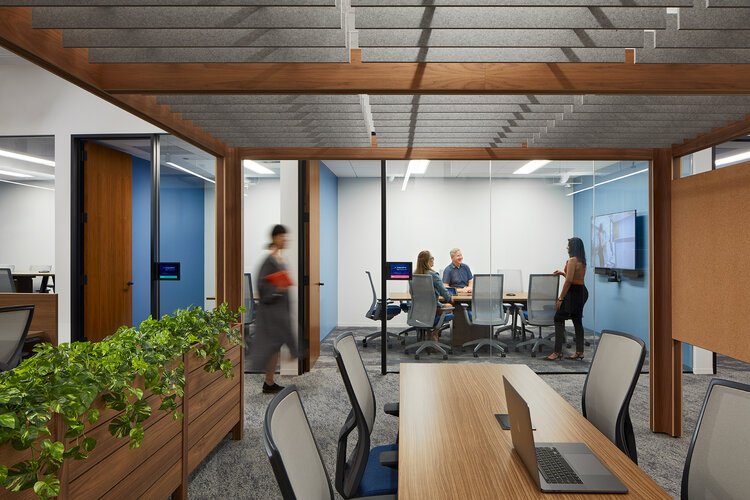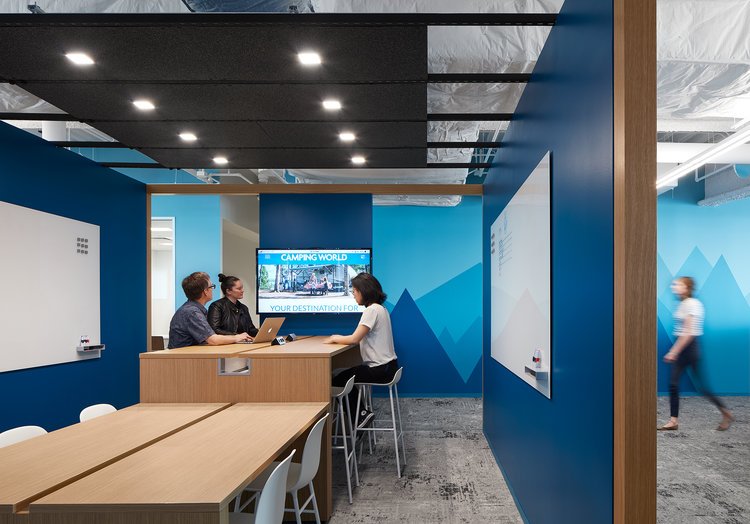Design Insights for a Fierce New Year
Tiger in the Jungle, Paul Elie Ransom, 1893. Smart Museum of Art, University of Chicago.
In the early days of the pandemic, our team of designers, along with many others across the globe, strategized about how the office of the future could better support wellness, inclusion, creativity. Nearly two years later, we are seeing projects planned and built using many of our projections.
Kicking off the Year of the Tiger, Eastlake Designers Megan Stroud, Meg Voloch, and Carla Schrader got together to document shifts happening in response to the pandemic that prioritize workers and build enthusiasm about returning to the office. They also gathered some key trends from the past year that reflect the intensified focus on mental and physical health and the importance of nature.
Old Post Office Suite 10N
All workplace photos by Kendall McCaugherty, Hall + Merrick + McCaugherty Photographers.
COLORS & SHAPES
Soft curves, natural materials, and muted tones reflect 2022’s zeitgeist.
—Carla Schrader
Calm palettes that call to mind nature, geography, and nostalgia fit the mood of an era where everyone is seeking solace. We’re seeing Scandinavian schemes, Y2K pastels, and earthy and craft influences from the 1970s.
Brown has made a resurgence. Despite gray tones dominating the workplace for the past decade, the pendulum is swinging back towards warmer colors. This trend is manifested in taupes, creams, rusts, nudes, and even dusty rose. We feel this is also connected to the biophilia that has shaped the workplace through natural finishes and plant-mania.
Curves bring a similar sense of tranquility to a space, and compliment these popular palettes. Dramatic archways, a structural development that is thousands of years old, can add drama and frame prime areas of a workplace. Sofas with sloping backs and barrel-style chairs compliment organic architectural references for a cohesive look.
222 N LaSalle Marketing Suite
175 W Jackson Marketing Suite
CHOICE
The “Great Resignation” has meant that the employee is king right now. Companies are being more sensitive to what people want and need in hopes of retention.
– Megan Stroud
The autonomy found in work-from-home life is something that many workers wish to maintain as they return to the office. Spaces for focused, interruption-free work and collaborative tasks continue to be important, but now designing for a variety of technology needs and work styles is vital to productivity and happiness. Examples include phone rooms, designated quiet workstations, and functional lounges, where people can work on sofas or café tables. Choice can also be offered through customizations, like peg boards and chair types available in personal work areas.
300 N LaSalle Marketing Suites
FLEXIBILITY
While this is not a new term, it means more than it ever has. As footprints shrink, flexibility grows.
—Meg Voloch
The difference between now and a few years ago is that flexibility is on steroids. Ideally, each office should be a living, breathing organism that supports all future possibilities before they're even realized. People want furniture they can move themselves quickly, and space is too valuable to have a static purpose.
Smart technology increases a workforce’s agility and ability to move throughout a space, and supports flexibility for today’s new standards. And after all of that time away from the office, flex options in communal spaces can help create a deeper sense of community.
Practicality aside, flexible design is also more sustainable and financially responsible. With the growing awareness of the carbon footprint of interior renovations, multi-function furniture will continue to be the smartest choice for the environmentally conscious, extending the life of the product and keeping it out of the landfill.
Old Post Office Suite 10N
Siemens
SPACE WITHIN A SPACE
A major change we’ve been seeing is more budget for furniture. Furniture can help achieve a more flexible design, and new styles can act architecturally within an open space.
–Carla Schrader
Creating a feeling of safety and protection through structure and clearly defining regions of the office has been more crucial over the last year. Screens, phone booths, and high back seating can permeate the space architecturally, without building new walls, and can be moved and integrated with tech.
There has also been an influx of manufacturers producing customizable pavilions, trellises, and pergolas, making it easier to decrease the amount of permanent architecture in an office that demands day-to-day changes.
1 S Wacker Marketing Suite
HIGH TECH ALL OVER
With remote work schedules becoming more common, we’re seeing a rise in digitally inclusive meeting and workspaces that allow for virtual connections to coworkers, clients, and collaborators.
– Megan Stroud
What has changed since the pandemic? All spaces need tech now, whether they be open collaboration areas, conversation rooms, or coffee bars. Every space is a potential touchdown area and should have the flexibility to become part of a virtual space.
Technology is also influencing the design process. Driven by the pandemic, user experience and inclusivity-focused design is more important than ever. UX design tactics utilize psychology and analytics to build the perfect space based on the behaviors of the end user, and we know this will be integral to the best workplaces of the future.
iManage
Camping World
THE DESTINATION OFFICE
Incentivizing people to come back into the office has resulted in two main approaches that we’ve seen: cozy spaces that share the perks of home and brand-focused experiences that contrast with the home office.
—Meg Voloch
Office or boutique hotel? Whether the vibe reflects residential comforts or boldly proclaims its individuality, we have been designing spaces that share elements with hotels and creative clubs with co-working capabilities, similar to Soho House.
Workplaces featuring subdued colors, soft seating, and lots of variety in work surfaces, is one side of the coin aimed at capturing the comforts of working from home. On the flip side, many companies are leaning heavily into their brand definition as a way to reinvigorate workers and contrast their work-from-home experience.
Both styles utilize hospitality trends (fireplaces, theater rooms, speakeasies) within the commercial office space, which is an ongoing trend we’ve been seeing for a while that has been amplified by the pandemic.
Old Post Office Suite 2E, Mail Chute Bar
iManage Library
ActiveCampaign Theater-inspired Lounge
WELLNESS IS EVERYTHING
Designing for wellness means more than adding plants and a yoga room. It’s an intrinsic piece of an organization’s success and productivity.
– Megan Stroud
Wellness has taken on a more holistic shape recently, with elements woven into every part of the design process. From simple color choices to temperature control to fitness center subsidies, there’s a myriad of tactics that can lead to healthier workplaces if a designer understands the experience of the end user.
One way to successfully integrate a wellness plan into a design is to allow users to control their own micro-environments, which may include lighting, temperature, and acoustic considerations.
McCaffery Deck
iManage Prayer & Meditation Room
150 N Michigan Amenities

















